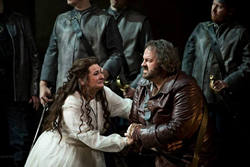| Opera Reviews | 20 April 2024 |
A rewarding performanceby Catriona Graham |
|
| Verdi: Il Trovatore Scottish Opera May 2015 |
|
|
Martin Lloyd-Evans has left the stage all but bare, defined by three curved panels, which are configured as walls, towers, entrances. They also provide surfaces for the shadows thrown by Robert B. Dickson’s lighting – Manrico’s and the Count’s loom large and threatening while Leonora casts hardly any at all. Although Kally Lloyd-Jones moves the chorus well, the main characters tend to ‘stand and sing’ - the drama lies in the music. Manrico was brought up by Azucena as her son after she had (mistakenly) thrown her own son into the flames of her mother’s ashes. He has no idea he is the brother of the Count, and they are fighting on opposite sides. Gwyn Hughes Jones has a clear, lissome voice and a delicious line – particularly his pre-marital aria Ah si, ben mio. Roland Wood is a robust Count, with a rich sound in both extremes of his range. The vocal duel between the Count and Manrico in Act 2 highlights the characters of the two voices most effectively. Leonora is a fairly passive character, her only action when she offers herself to the Count to save Manrico’s life, but takes poison. Yet Claire Rutter invests her with dignity in a sweet-voiced performance. Anne Mason is a stunning Azucena, in drab, dull red, and with a voice supple and full of emotion. As she lies in the tower awaiting her death, her singing is as full of longing as it conveys her exhaustion. The trio with Leonora and Manrico is very intense. Much earlier, in Act 2, when she falls down exhausted from telling Manrico how she has loved and cared for him, her prostration emphasises the lowness of these last notes The chorus is excellent. The men’s diction is crisp and precise – consonants almost percussive at the start of Act 3. The Count’s army is in blue trousers and grey jackets, Manrico’s in red trousers and grey jerkins. The gypsies are in muted greys, blues, greens and browny reds. The procession of nuns provides a rare bright spot, their white habits almost glowing in the light. In the pit, conductor Tobias Ringborg brings out the complex textures in the music and the often surprisingly jaunty orchestral rhythms with which Verdi underpins the soaring vocal lines. The orchestra is playing well, creating a large sound yet maintaining a delicacy in the softer passages. Despite the bleakness of its story, this is a rewarding performance to see and hear.
|
|
| Text ©
Catriona Graham Photo © KK Dundas |

 The storyline of Il Trovatore hardly makes for the most joyous or uplifting of operas. Its plot of two brothers, separated as children, in love with the same woman, Leonora is coupled with two different strands of vengeance, which leaves two dead and one about to die at the end. The Count seeks vengeance on the gypsy woman Azucena who ‘kidnapped’ his brother, and the woman seeks vengeance on the Count as the man who burnt her mother at the stake as a witch.
The storyline of Il Trovatore hardly makes for the most joyous or uplifting of operas. Its plot of two brothers, separated as children, in love with the same woman, Leonora is coupled with two different strands of vengeance, which leaves two dead and one about to die at the end. The Count seeks vengeance on the gypsy woman Azucena who ‘kidnapped’ his brother, and the woman seeks vengeance on the Count as the man who burnt her mother at the stake as a witch.






